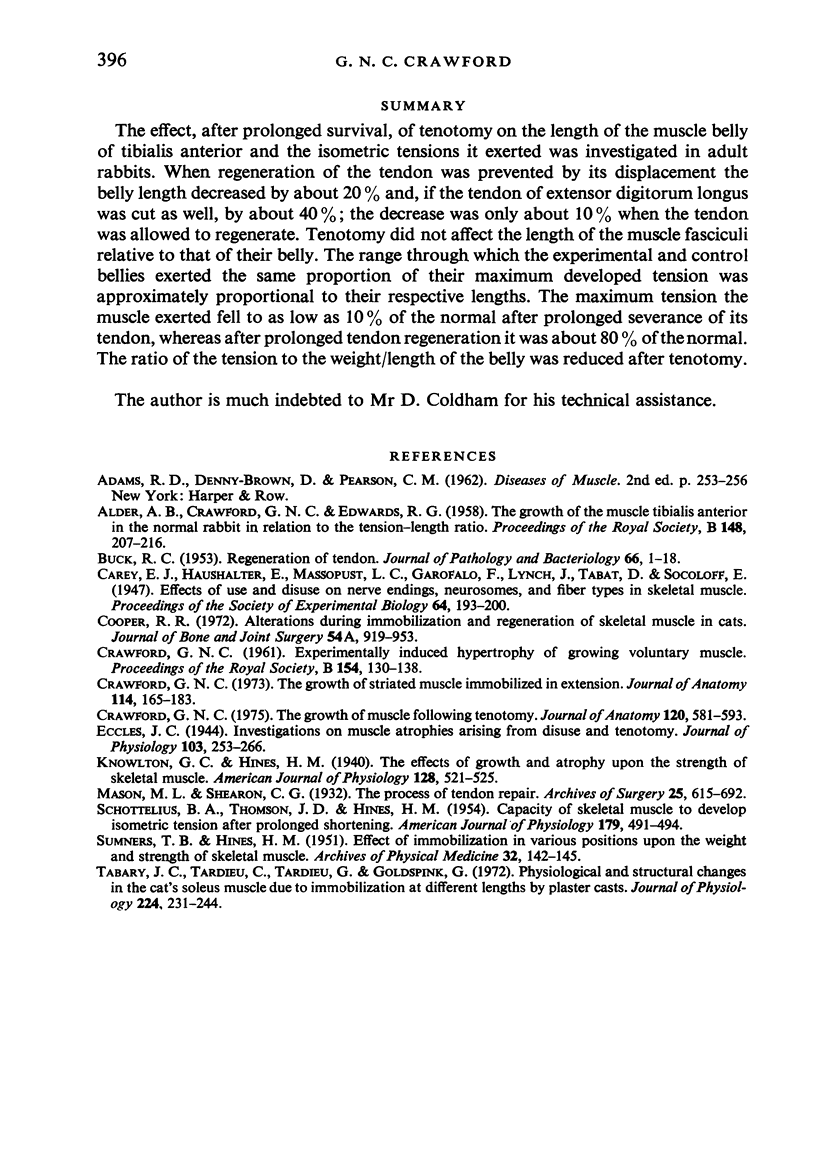Abstract
The effect, after prolonged survival, of tenotomy on the length of the muscle bell of tibialis anterior and the isometric tensions it exerted was investigated in adult rabbits. When regeneration of the tendon was prevented by its diplacement of bell length decreases by about 20% and, if the tendon of extensor digitorum longus was cut as well, by about 40%; the decrease was only about 10% when the tendon was allowed to regenerate. Tenotomy did not affect the length of the muscle fasciculi relative to that of their belly. The range through which the experimental and comtrol bellies exerted the same proportion of their maximum developed tension was approximately proportional to their maximum developed tension was approximately proportional to their respective length. The maximum tension the muscle exerted fell to as low as 10% of the normal after prolonged severance of its tendon, wheras after prolonged tendon regeneration in was about 80% of the normal. The ratio of the tension to the weight/length of the belly was reduced after tenotomy.
Full text
PDF







Selected References
These references are in PubMed. This may not be the complete list of references from this article.
- ALDER A. B., CRAWFORD G. N., EDWARDS R. G. The growth of the muscle tibialis anterior in the normal rabbit in relation to the tension-length ratio. Proc R Soc Lond B Biol Sci. 1958 Feb 18;148(931):207–216. doi: 10.1098/rspb.1958.0014. [DOI] [PubMed] [Google Scholar]
- BUCK R. C. Regeneration of tendon. J Pathol Bacteriol. 1953 Jul;66(1):1–18. [PubMed] [Google Scholar]
- CRAWFORD G. N. Experimentally induced hypertrophy of growing voluntary muscle. Proc R Soc Lond B Biol Sci. 1961 Apr 18;154:130–138. doi: 10.1098/rspb.1961.0024. [DOI] [PubMed] [Google Scholar]
- Cooper R. R. Alterations during immobilization and regeneration of skeletal muscle in cats. J Bone Joint Surg Am. 1972 Jul;54(5):919–953. [PubMed] [Google Scholar]
- Crawford G. N. The growth of muscle following tenotomy. J Anat. 1975 Dec;120(Pt 3):581–593. [PMC free article] [PubMed] [Google Scholar]
- Crawford G. N. The growth of striated muscle immobilized in extension. J Anat. 1973 Feb;114(Pt 2):165–183. [PMC free article] [PubMed] [Google Scholar]
- Eccles J. C. Investigations on muscle atrophies arising from disuse and tenotomy. J Physiol. 1944 Dec 15;103(3):253–266. doi: 10.1113/jphysiol.1944.sp004074. [DOI] [PMC free article] [PubMed] [Google Scholar]
- SCHOTTELIUS B. A., THOMSON J. D., HINES H. M. Capacity of skeletal muscle to develop isometric tension after prolonged shortening. Am J Physiol. 1954 Dec;179(3):491–494. doi: 10.1152/ajplegacy.1954.179.3.491. [DOI] [PubMed] [Google Scholar]
- Tabary J. C., Tabary C., Tardieu C., Tardieu G., Goldspink G. Physiological and structural changes in the cat's soleus muscle due to immobilization at different lengths by plaster casts. J Physiol. 1972 Jul;224(1):231–244. doi: 10.1113/jphysiol.1972.sp009891. [DOI] [PMC free article] [PubMed] [Google Scholar]


